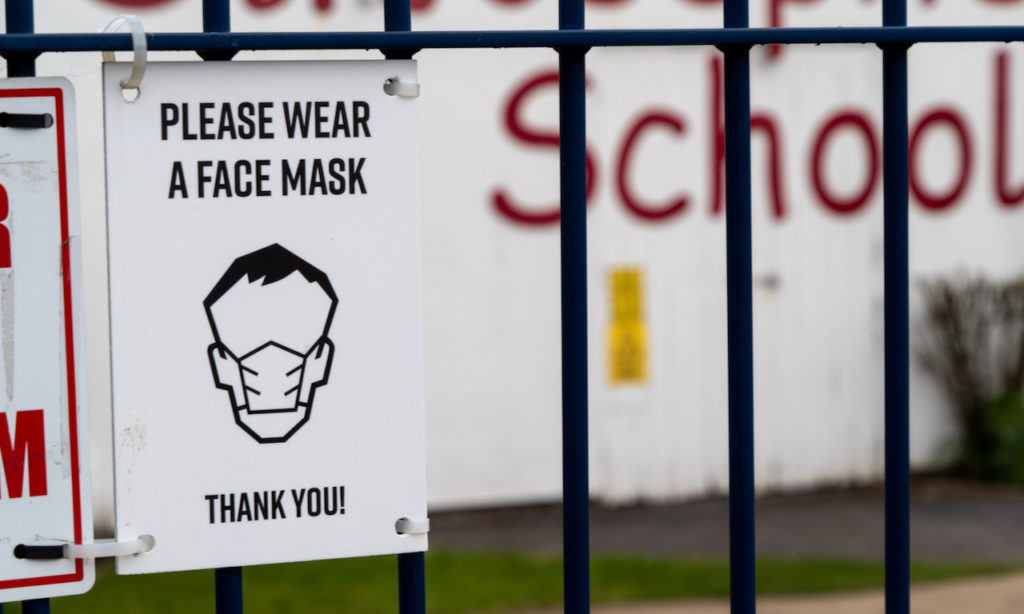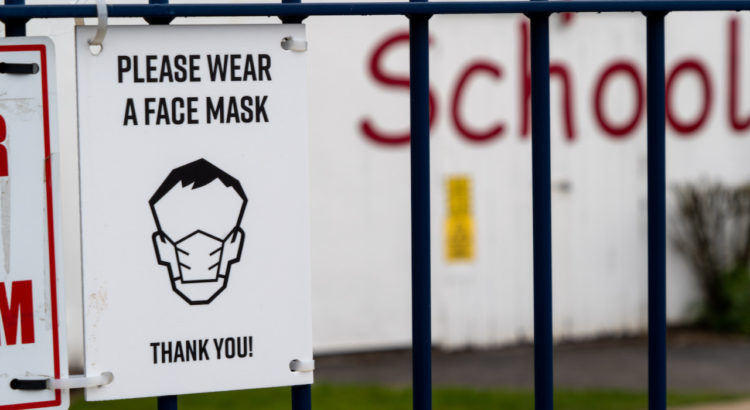
The cruel ritual continues in spite of no robust evidence
On New Year’s day, just when we should have been giving children a positive message at the start of 2022, it was instead announced that secondary school pupils would again have to wear masks in class. This is despite known harms to children’s education and mental health from mask wearing, and a lack of any robust evidence that masks in class reduce transmission. The latest variant is now confirmed to be much milder than previous ones, however, yet again children are being detrimentally affected due to the paranoia of adults.
Are there any benefits?
It has been widely shown that schools are not a major driver of community infection rates, merely a reflection of them, with teaching being a low risk profession. Adults living with young children actually have a lower risk of becoming severely ill or needing hospitalisation if they do catch Covid. Children themselves have an extremely low risk from Covid-19 and indeed many who had a SARS-CoV-2 infection last term will have good immunity and be unlikely to catch it and pass it on. It has been suggested that masks are needed to ensure schools can re-open; a much simpler solution would be to stop testing asymptomatic staff and pupils, only isolating those who are symptomatic.
Although we are repeatedly told that masks reduce transmission, this is based on low quality evidence. An evidence summary from the Department for Education adds nothing significant. It quotes the many laboratory studies and several observational studies, also quoting two randomised control trials (RCTs), both carried out in adults and neither showing a significant benefit. The Danish study using surgical masks showed an absolute risk reduction (ARR) of 0.3% (p=0.38). A large study in Bangladeshi villages showed a 1.1% ARR in covid-like symptoms for surgical mask users, ARR only 0.7% for cloth masks (p=0.48). These figures were further reduced for those with antibody confirmed infections, showing no significant benefit for cloth mask wearers. Interestingly also the benefit was reserved for older age groups, ARR for confirmed infections 0.34% in the over 60s, was not shown for under 40s where there was no reduction. Thus neither of these RCTs make the case for masking healthy adults, let alone children.
Included in the UK Government’s evidence summary as an annex is a report on school Covid absence rates from 123 secondary schools where face masks were in use and a further group of schools not wearing masks, followed for only 2-3 weeks during October. Both groups showed a fall in absence rates with non-mask-using schools falling from 5.3 to 3.6% and the mask using schools falling from 5.3 to 3.0%. This is a 0.6% absolute risk reduction. But this was apparently using weighted data — the unweighted data actually showed 2.9% in the unmasked group, giving 0.1% increase for the masked! The study is described as having ‘a level of statistical uncertainty’ and with a p value of 0.15. This observational study is certainly not a basis for Nadhim Zahawi to defend the introduction of face masks for 3 million school children in England. The excuse provided for not carrying out an RCT — ‘due to the speed and ever-changing nature of the pandemic, conducting an RCT is not possible’. We have been here for 22 months, and it is the ‘ever-changing’ situation that makes use of RCTs rather than observational studies even more vital. Millions upon millions of children around the world have been forced into face masks, in some countries even down to nursery age, yet not one health ministry has instigated an RCT, maybe because they know that if the results were negative, it would finally call out the harm that is being pushed onto children for no known benefit.
The philosophy of the government seems to be that any measures are worth trying in the hope that they might “do something”, and with no attempt to quantify whether any of these benefits manifest themselves or how damaging the huge list of harms [BdeH suggestion to add “from these measures” here] actually are. This Brownstone Institute review is recommended reading for Mr Zahawi.
What are the potential physical harms?
Wearing masks for prolonged periods of time have been associated with a variety of harms, including reduced oxygen levels, raised CO2 levels, headaches and lethargy, acne and impetigo, eye irritation, damp masks growing bacteria and fungi. Cloth masks have been shown to increase respiratory infections in healthcare staff. For children with enlarged tonsils and adenoids, face masks may be even more problematic — these children tend to be mouth breathers and prone to sleep apnoea. Covering the nose and mouth reduces clean air flow through the nose to be filtered and humidified, consequently fresh air is not passing through the upper airways, which increases the likelihood of infection such as tonsilitis or sinusitis.
What of the educational impact?
The evidence summary from the DfE states that ‘ the risks of potential negative impacts on teaching, learning and wider health and wellbeing have needed to be balanced against the benefits of face coverings’ but gives no evidence for how this has been done.
These difficulties are particularly severe for children with hearing impairment who can miss out educationally and also in their interaction with their friends if masks are mandated.
Hearing aid use is a protected characteristic under disability discrimination act 2010 and means those with hearing impairment are allowed to request that those they are communicating with remove their mask but this has not been occuring due to a combination of fear of not masking and fear of asking.
In a survey by the DfE last April, 94% of secondary school teachers thought that wearing face coverings made communication between teachers and students more difficult, with 59% saying it has made it a lot more difficult. Research into the effect of mask wearing on communication has found that concealing a speaker’s lips led to lower performance, lower confidence scores and increased perceived effort on the part of the listener. Moreover, meta-cognitive monitoring was worse when listening in these conditions compared with listening to an unmasked talker.
Apparently teachers will not be required to wear masks while speaking; this implies that learning is just about children sitting listening to their teacher. This is a far cry from modern educational methods, where class participation is assessed as integral to learning. Developing purposeful student talk in the classroom is an essential role of any teacher. Language development is vital for all students as educational theory shows the inextricable connections between thought and language. Children learn more by doing than by being passive and that includes speaking and not just listening. Talking helps shape children’s understanding. It doesn’t just show and reflect what they already know. Peer-to-peer talk is especially important, and in some ways superior, to teacher to student talk, as it furthers a child’s ability to create knowledge and understanding: it is much more likely that they will question and challenge each other further and deeper during the conversation to arrive at what makes logical sense to them. Much of this is lost when masks are worn.
Psychological impacts
The psychological impacts of masking cannot be overstated and are summarised clearly on www.smilefree.org. ‘Humans are social animals. We need to interact with others and communicate to sustain our wellbeing. The reactions of the people we meet provide continuous feedback about ourselves and the impact we are having on our fellow citizens. Masks are a major impediment to all these human requirements and, as such, they are de-humanising.’
Wearing face coverings inhibits emotional expression and social interaction and aggravates existing anxiety problems, resulting in re-traumatisation.
More importantly, masks serve to maintain elevated levels of fear and promote mindless compliance – see the accompanying article here.Pupil power – mask wearing in schools is government guidance and is not mandatory and it seems that in some schools pupil power is finally being heard. Perhaps the top-down imposition of these pointless mandates has triggered some young enquiring minds to challenge the Government’s pseudoscience. Good for them for making a stand.

